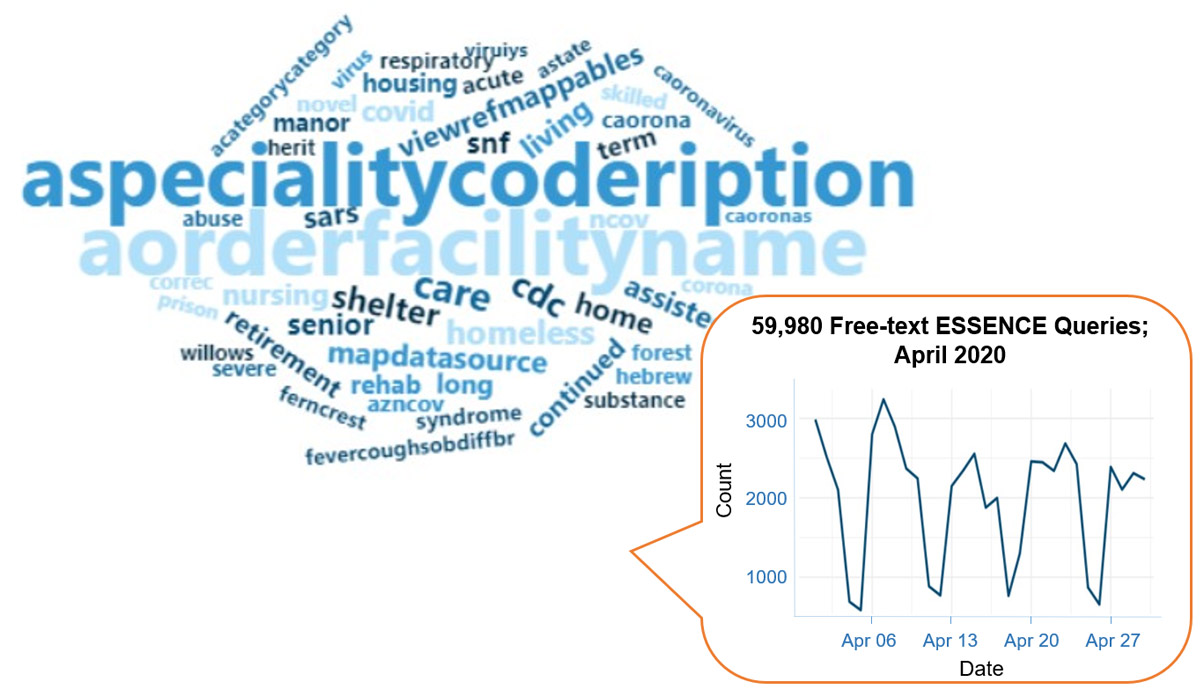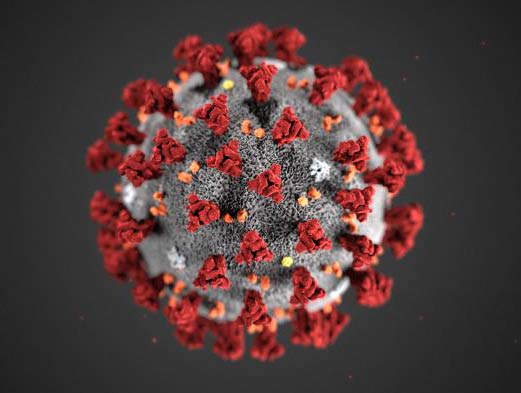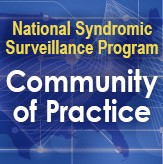NSSP Update – May 2020

A Technical Newsletter for the NSSP Community of Practice | May 2020
[/vc_column_text][/vc_column][/vc_row]
Community of Practice
COVID-19 Slack Channel
The NSSP Community of Practice (NSSP CoP) has created a Slack channel to facilitate real-time discussion among its members, NSSP staff, and other stakeholders who support the COVID-19 response. Some community members are using Slack to get feedback they can use to improve queries, while others are using the channel for concensus gathering. Slack is, essentially, a collaborative hub for sharing files and ideas in one searchable space. To join ongoing conversations about the coronavirus response, please email nssp@cdc.gov with the subject line “Add to COVID-19 Slack.”
NSSP Community of Practice Supports the COVID-19 Response
Like many public health professionals, syndromic surveillance practitioners are actively engaged in the ongoing COVID-19 response. Throughout this response, the NSSP Community of Practice (NSSP CoP) has worked to support its members and the syndromic surveillance community.
The March 2020 NSSP CoP Call highlighted the many syndromic surveillance activities the community is engaged in during the ongoing COVID-19 response. Epidemiologist Kathleen Harnett (CDC NSSP) shared an NSSP–ESSENCE dashboard visualizing commercial laboratory data, Program Manager Mike Coletta (CDC NSSP) provided an overview of the mortality data pilot project, and Health Scientist Aaron Kite-Powell (CDC NSSP) shared an R Shiny Dashboard for COVID-19 exploratory analysis. (Previously, NSSP had assisted stakeholders by supporting analyses that compared COVID-19 with flu.) The call concluded with a state-based presentation from Epidemiologist Natasha Close (WA) on weekly COVID-Like Illness (CLI) syndromic surveillance reports being used by the Washington State Department of Health. Learn more by watching the call recording and reviewing the call notes here.

Community Highlights
NSSP Community of Practice
- Check out previous call recordings and other resources from the NSSP Community of Practice (CoP) here.
NSSP CoP Core Committee
- The NSSP CoP Core Committee continues to meet monthly to discuss ongoing activities, priorities, and needs of the syndromic surveillance (SyS) community.
- As a reminder, if you have a topic for Core Committee consideration, please email syndromic@cste.org.
Data Quality Subcommittee
- The DQ Subcommittee hosted an ad hoc call in April in which Epic and Cerner liaisons described ways to improve electronic health records (EHR) for the COVID-19 response.
- Epic and Cerner are sending the ICD-10 code for COVID-19 (i.e., U07.1) and will send ventilator use data through PR1 segments;
- Epic is sending employer and occupation data through OBX segments; and
- To support consistency, EPIC is developing recommendations for data entry.
- On the regularly scheduled April 2020 DQ call, subcommittee members listened to an update from Thought Bridge on a project funded by the Council of State and Territorial Epidemiologists (CSTE) to identify ways to improve the quality and completeness of EHR data for SyS. Additionally, Sophia Crossen (ICF contractor for CDC NSSP) presented on “Flavors of Duplication” and cited examples of use cases that contained duplicate messages.
- Check out previous call recordings and other resources from the DQ Subcommittee here.
Knowledge Repository Curation Subcommittee
- Do you have syndromes, resources, or anything related to SyS that you would like considered for addition to the NSSP CoP Knowledge Repository? If so, please email syndromic@cste.org.
- Email syndromic@cste.org if you have any issues with the KR.
Overdose Surveillance Subcommittee
- The OS Subcommittee meets bi-monthly. The next call is scheduled for May 15, 2020.
- Check out previous call recordings and other resources from the OS Subcommittee here.
Syndrome Definition (SD) Subcommittee
- On the April 2020 call, the SD Subcommittee hosted Marissa Zwald (CDC National Center for Injury Prevention and Control, Division of Violence Prevention). Zwald presented on suicide-related syndrome definitions and gave an update on the Emergency Department Surveillance of Nonfatal Suicide-Related Outcomes (ED-SNSRO) project.
- Check out previous call recordings and other resources from the SD Subcommittee here.
Syndromic Surveillance and Public Health Emergency Preparedness, Response, and Recovery (SPHERR) Subcommittee
- SPHERR subcommittee calls will now be held once monthly, on the first Friday of the month.
- Check out previous call recordings and other resources from the SPHERR Subcommittee here.
Technical Subcommittee
- The next Technical Subcommittee call is scheduled for July 2020.
- Check out previous call recordings and other resources from the Technical Subcommittee here.
Spotlight on the Knowledge Repository Curation Subcommittee
The Knowledge Repository (KR) Curation Team recently reconvened as the KR Curation Subcommittee with the purpose of curating the KR for accuracy, timeliness, and utility. The KR Curation Subcommittee’s first action will be to develop a process for reviewing KR submittals. You’ll hear more from the KR Curation Subcommittee in the coming months.
The Knowledge Repository is an online database of surveillance-related resources—including abstracts, syndromes, trainings, and webinars—provided free to public health professionals. These resources target the interests of NSSP CoP members. Almost 90% of members state that the NSSP CoP and KR resources have improved their knowledge, skills, and abilities related to syndromic surveillance.
The KR hosts more than 2,800 pages of resources with about 1,400 page views each month. The KR includes 50+ syndromes available in the Syndrome Definition Library, at least 30 Stories of Surveillance in Action, and almost 200 recorded webinars.
If you have syndromes, resources, or anything related to syndromic surveillance that you would like considered for addition to the NSSP CoP Knowledge Repository, please submit a request form here.
Knowledge Repository Curation Subcommittee
Link to KR Resources | A call schedule will be posted soon on the NSSP CoP calendar.
Co-Chair: Teresa Hamby (NJ)
Co-Chair: Yushiuan Chen (Tri-County, CO)
Link to Meeting Resources on KR
If you’d like to join the KR Curation Subcommittee, please email syndromic@cste.org.
ESSENCE Queries
March and April 2020


A key feature of NSSP–ESSENCE is its ability to use free-text definitions across different fields to generate custom queries. The syndromic surveillance community can use this feature to develop and refine category definitions and to identify and respond to public health events that may not be apparent in established categorical definitions (i.e., syndromes, subsyndromes, and Chief Complaint and Discharge Diagnosis [CCDD] categories).
This word cloud summarizes free-text and coded values that epidemiologists and data analysts queried in ESSENCE during March and April 2020. We created it by using the Wordcloud2 package in RStudio. The relative size of the terms suggests the frequency of use in a query. NSSP super administrators can query ESSENCE usage logs to learn what queries are run nationwide and how long they take to complete.
- CLI CC with CLI DD and Coronavirus DD v1—This query was created to allow patients to meet the Corona-like Illness definition through the Discharge Diagnosis codes if not already meeting the definition through their Chief Complaints. It also pulls in visits meeting the Coronavirus DD query along with a few other coronavirus ICD10 codes included in the CDCs interim guidance document.
Query: Search the CCDD Category field and Also apply to Discharge Diagnosis: ^;Fever and Cough-Sob-DiffBr neg Influenza DD v1;^,or,^;CDC Coronavirus-DD v1;^,or,(,(,^[;/ ]R50.9^,or,^[;/ ]R509^,),and,(,^[;/ ]R05^,or,^[;/ ]R06.02^,or,^[;/ ]R0602^,or,^[;/ ]R07.0^,or,^[;/ ]R070^,),),andnot,(,^[;/ ]J09^,or,^[;/ ]J10^,or,^[;/ ]J11^,or,^[;/ ]487.[018][;/ ]^,or,^[;/ ]487[018][;/ ]^,or,^[;/ ]488.[018][19][;/ ]^,or,^[;/ ]488[018][19][;/ ]^,or,^[;/ ]442696006[;/ ]^,or,^[;/ ]442438000[;/ ]^,or,^[;/ ]6142004[;/ ]^,or,^[;/ ]195878008[;/ ]^,),or,^[;/ ]J98.8^,or,^[;/ ]J988^,or,^[;/ ]J22^,or,^[;/ ]J80^
- UPDATED CDC Coronavirus-DD v1—The CDC Coronavirus-DD v1 category has been updated and now includes the new ICD10CM U07.1 code, used to assign a disease diagnosis of COVID-19 as confirmed by laboratory testing. The update also removed the 840534001 SNOMED code previously in the query, that was in fact for “SARS-CoV2 Vaccination”. This should not affect any existing dashboards or queries using this category, given this was simply an update of an existing category, and not a creation of a version 2. The removal of the SNOMED code should also not affect numbers in any way due to it being for SARS-CoV2 vaccination. In fact, it was removed to more future-proof the query. Please reach out via JIRA in case of any questions.
Query: Search Discharge Diagnosis field: ^[;/ ]B34.2^,or,^[;/ ]B342^,or,^[;/ ]B97.2^,or,^[;/ ]B972^,or,^[;/ ]J12.81^,or,^[;/ ]J1281^,or,^[;/ ]079.82[;/ ]^,or,^[;/ ]07982[;/ ]^,or,^[;/ ]480.3[;/ ]^,or,^[;/ ]4803[;/ ]^,or,^[;/ ]V01.82[;/ ]^,or,^[;/]V0182[;/ ]^,or,^[;/ ]27619001[;/ ]^,or,^[;/ ]186747009[;/ ]^,or,^[;/ ]651000146102[;/ ]^,or,^[;/ ]713084008[;/ ]^,or,^[;/ ]398447004[;/ ]^,or,^[;/ ]408688009[;/ ]^,or,^[;/ ]441590008[;/ ]^,or,^[;/ ]715882005[;/ ]^,or,^[;/ ]840539006[;/ ]^,or,^[;/ ]840544004[;/ ]^,or,^[;/ ]840546002[;/ ]^,or,^[;/ ]840536004[;/ ]^,or,^[;/ ]840535000[;/ ]^,or,^[;/ ]840533007[;/ ]^,or,^[;/ ]U07.1^,or,^[;/ ]U071^

Collaborations between health departments and CDC programs* improve how syndromic surveillance gets done. The list of collaborations that follows, while not exhaustive, summarizes ongoing efforts to develop and improve syndrome definitions, conduct pilot tests and exercises, and improve processes to achieve public health goals more efficiently:
- Develop syndrome definition for pregnancy, delivery, and miscarriage.
- Collaborator: CDC’s Maternal and Infant Health/Maternal and Infant Health Branch
- THE SYNDROME DEFINITION IS COMPLETE! NSSP will inform the community when this definition is available for use and has been added to the Knowledge Repository.
- Develop syndrome definition for injecting drug users and endocarditis (infection of inner lining of heart chamber and valves).
- Collaborator: CDC’s National Center for Emerging and Zoonotic Infectious Diseases, Epidemiology Research and Innovations Branch
- Develop syndrome definition for motor vehicle collision syndrome.
- Collaborator: CDC’s Division of Unintentional Injury Prevention and the Transportation Safety Team
- THE SYNDROME DEFINITION IS COMPLETE! NSSP will inform the community when this definition is available for use and has been added to the Knowledge Repository.

- Develop syndrome definition for child abuse and neglect.
- Collaborator: CDC’s Division of Violence Prevention
- THE SYNDROME DEFINITION IS COMPLETE! NSSP will inform the community when this definition is available for use and has been added to the Knowledge Repository.
- Develop syndrome definition for child sexual abuse.
- Collaborator: CDC’s Division of Violence Prevention
- Develop syndrome definition for teen dating violence.
- Collaborator: CDC’s Division of Violence Prevention
- Develop syndrome definition for homeless populations.
- Collaborator: CDC’s Division of Violence Prevention
- THE SYNDROME DEFINITION IS COMPLETE! NSSP will inform the community when this definition is available for use and has been added to the Knowledge Repository.
- Develop syndrome definition for animal bites.
- Collaborator: CDC’s National Center for Environmental Health
- Develop syndrome definition for synthetic marijuana.
- Collaborator: CDC’s Opioid and Overdose Team
- Develop strategies to capture radiation exposures following a radiation disaster and examine whether syndromic surveillance can use poison control center data to supplement existing radiation exposure surveillance.
- Collaborator: CDC’s National Center for Environmental Health
- Assess whether snake bites increase after natural disasters and if data from NSSP and poison control centers can be incorporated to analyze snake bite incidence pre- and post-disaster.
- Collaborator: CDC’s National Center for Environmental Health
*The priorities driving these projects may change. Content is updated monthly to keep current with agency and program changes.
Technical Updates
Commercial Lab Data in NSSP–ESSENCE

NSSP–ESSENCE currently houses data from six commercial labs. You can query these data by individual lab sources by using the Lab Data Source field. You will see the different labs indicated by the letters, A, B, C, D, E and F. This was done to maintain anonymity of our commercial lab partners in accordance with our Data Use Agreement.
All lab data sources include COVID tests, and lab source A includes all reportable diseases plus opioid-related tests. You can search across all data sources using Lab Keyword Syndrome, a field based on the same idea as Chief Complaint Discharge Diagnosis (CCDD) categories in emergency department data. This field allows you to query on options of orders, results, and test types (e.g., serology, polymerase chain reaction, or “PCR”). The ESSENCE lab dashboard reflects orders and results to include all six labs.
Please email us with questions at nssp@cdc.gov or submit a ticket to the NSSP Service Desk (support.syndromicsurveillance.org).
NSSP Stands Ready to Support Onboarding Needs
NSSP is an essential source of data for improving situational awareness at all levels of local, state, and federal government. Our data reflect new analyses, syndrome categories, and visualization techniques developed over the past month or so, and these data will likely influence your decision-making.
Currently, the NSSP captures about 73% of all ED visits across the country, though coverage is sparse in some areas. To meet the need for critical information, the onboarding team is making every effort to fill in the gaps by increasing the proportion of ED visits that transmit data to the BioSense Platform.
For help with onboarding facilities, please submit a ticket to the NSSP Service Desk. We’d also like to know the status of your pending feeds. Site administrators can provide this information by submitting a service ticket, and a member of the onboarding team will follow-up.
NSSP Sets Up ESSENCE API Server
NSSP set up an additional ESSENCE application programming interface (API) server to handle data requests being transmitted via the ESSENCE data-access API. This will make the primary ESSENCE web application server more readily available and responsive to users.
DQOD Staging Reports Coming Soon
NSSP has made significant progress over the past month to accelerate development of the Data-Quality-On-Demand (DQOD) reports that will be launched in the staging environment. We are testing the DQOD reports now with plans to release the reports in May. If you are a site administrator and need the reports sooner, please contact the NSSP onboarding team by submitting a service desk ticket. We’ll be pleased to provide DQOD reports tailored for your site.
NSSP Publishes New User Manual

BioSense Platform User Manual for SAS Studio—The manual explains how to configure your SAS account and efficiently use SAS Studio to connect to and analyze your site’s data. Also covered are the features, basic interface, navigation, and functionality. Published in April 2020!
Look for user manuals in the Technical Resource Center, Technical Publications and Standards.
Current Month and Upcoming Events
| May 19 | Apply vendor patches in Testing and Development environments: 6:00–10:00 AM ET |
| May 21 | Apply vendor patches in Onboarding and Production environments: 6:00–10:00 AM ET |
Last Month’s Technical Assistance
| April 21 | Deployed vendor patches in Testing and Development environments |
| April 23 | Deployed vendor patches in Onboarding and Production environments |
Participation: The map below shows participation in NSSP as of March 31, 2020, with 59 sites (47 states and the District of Columbia).


Definitions: NSSP consolidates facilities that provide data under a single data administrative authority called a site administrator. These facilities and single-site administrator constitute a site.
Coverage: NSSP publishes data for emergency department (ED) visit coverage each quarter. As of March 31, 2020, data from EDs covered about 73% of all ED visits in the country. There were 5,041 facilities, including 3,310 EDs from 59 sites (47 states and the District of Columbia), actively contributing data to the NSSP BioSense Platform. The calculation method is described in the December 2018 issue of NSSP Update.

